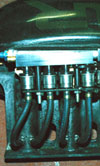Additive Controversy
 The subject of fuel additives is always a thorny subject in motorsport. As a competitor, there are always concerns associated with the ‘unfair’ advantage but if the vehicle is a historic one and designed to run on fuels that are no longer available, then the issues can run even deeper.
The subject of fuel additives is always a thorny subject in motorsport. As a competitor, there are always concerns associated with the ‘unfair’ advantage but if the vehicle is a historic one and designed to run on fuels that are no longer available, then the issues can run even deeper.
All gasoline fuels contain additives. Whether this is to reduce oxidation in the form of inhibitors or metal deactivators to minimise corrosion, these are added in small amounts to ensure that the fuel reaches the user in the best possible condition and causes as little damage to the supply network as is physically possible. Other performance-boosting additives may also be introduced and might include anti-ORI (octane requirement increase) or anti-pre-ignition. Spark-aiding additives, to assist lean burn combustion, might also be present as well as several other types designed to ‘help’ combustion along the way.
During the course of history the type and amount of these additives might be subject to change, partly as a result of changes in technology or for environmental considerations or both. One of these, Tetra Ethyl Lead or TEL was the subject of much debate twenty years ago.
Primarily an anti-knock additive, TEL was the most effective way of increasing the octane level of any gasoline. Decomposing in the combustion chamber at temperature, TEL forms a catalytically active cloud of metal oxide particles, which interfere with the rapid chain combustion that constitute detonation or engine ‘knock.’ Progressively limited by statute and then finally phased out altogether, the octane provided by the additive was steadily replaced first by improved refining introducing more aromatics / olefins to the mix but later, saturated hydrocarbons and various oxygenates.
One of the side effects that made TEL so attractive was its tendency to leave lead deposits in critical areas of the engine. In particular the lead used to accumulate on both intake and exhaust valve seats and act as a lubricant as the valve rotated on its seat. As a direct consequence of this, engine manufacturers would often choose to run fairly ‘soft’, unhardened valve seats which, when lead was removed from fuels, created prodigious valve seat wear issues. Easily cured at the manufacturing stage with hardened valve seats, in some engines, where the valves were too close together, a demand for aftermarket additives providing this missing lubrication was swiftly generated. The main constituents of these replacement additives are well known. Consisting of compounds containing sodium, potassium, phosphorus or manganese, these are now allowed by the motor sporting authorities, which is where much of the controversy begins.
In order for these to mix evenly in the fuel and ensure more accurate dosage, these compounds will need to be pre-mixed in a hydrocarbon ‘carrier’. This has to be clean burning and influence the fuel in the least way possible. In most cases toluene is the ideal choice but with blending octane numbers well in excess of the base fuel, inevitably some level of octane enhancement of the fuel is likely. At the dose rate required this is likely to be around 2 octane numbers. Furthermore while clearly phosphorus compounds cannot be used in conjunction with catalyst-equipped vehicles there is increasing evidence to suggest that all metallic fuel additives can be harmful to many exhaust gas sensors and control equipment. Thus while another additive, Methyl cyclopentadienyl Manganese Tricarbonyl or MMT may give excellent protection at the stated dose for older engines, its continued use in newer vehicles on a regular basis for its Octane increase alone, apart from being unnecessary, is likely to lead to long term damage of any engine closed loop control system. Unless engines are modified to take advantage of the extra octane available - for instance by increasing the compression ratio or advancing the ignition (where desirable), there would seem to be little point in using such additives.
The messages coming out from the UK Motor Sports Association in particular, is also confusing. While sodium, phosphorus, potassium and manganese are allowed for the purposes of lubrication, for some reason, manganese alone is limited to 0.005 gm/litre, a concentration which is only a fraction of that required for adequate valve seat protection. Maybe the MSA are heeding warnings from the vehicle manufacturers, but allowing its existence at such a low level even to historic vehicles, is surely confusing.
Whatever the additive at whatever the dosage, fuel additives will always be a contentious issue.
Written by John Coxon.